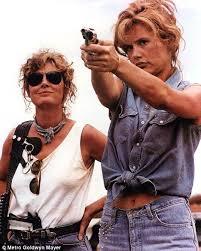The Villain Doesn’t Change
The craziest working arrangement I ever had in the screenwriting biz was when I worked for a producer I’ll call Joan Stark.
Joan insisted that I write in her office. I had to come in every day. Joan gave me a little cubbyhole beside the photocopy machine. I’d work on pages all morning and half the afternoon. Then we’d meet and Joan would go over the day’s work and give me corrections.

Susan Sarandon and Geena Davis as the heroes in “Thelma and Louise”
Every day she had problems with the same character—the villain.
She kept making me rewrite his scenes. One day I asked why. What mistake was I making?
You’re having the villain change. The villain can’t change.
I didn’t get it. “Why not?”
Because if the villain changed, he’d be the hero.
I remember thinking, That is the dumbest thing I’ve ever heard. Don’t we want the Bad Guy to be interesting? Shouldn’t he evolve like the Hero?
Answer: No.
The Alien doesn’t change. The shark in Jaws doesn’t change. The Terminator in The Terminator doesn’t change. And when he does in the sequels … OMG, he becomes the hero (or co-hero)—and we have new Terminators (who don’t change) who now become the villains.
I realized I had to start thinking more deeply about this.
Indeed external villains don’t change. Every antagonist in a James Bond movie. Every super-villain lining up against Batman, Superman, Spiderman, Iron Man, the Fantastic Four, the X-Men. Every force-of-nature villain (volcanoes, tsunamis, Mayan-predicted worldwide destruction, asteroids-crashing-into-Earth, Tripods invading New Jersey, global climate catastrophes). None of these is capable of change.
Zombies don’t change.
Vampires don’t change.
The Thing doesn’t change.
All these Bad Guys have one single-minded desire.
To eat your brain.
To suck your blood.
To destroy (or dominate) the world.
To give birth to baby Bad Guys.
Societal villains (as opposed to external villains) don’t change.
Racism in To Kill a Mockingbird, The Help, BlacKkKlansman.
Homophobia in Philadelphia, Dallas Buyers’ Club, Moonlight.
The societal villain in Thelma and Louise, written by Callie Khouri, (who won the Oscar for Best Original Screenplay) is male contempt for and domination of women.
The film depicts men as loutish husbands, leering truck drivers, sneak-thieving hitch-hikers, trigger-happy cops and FBI agents, and the arch-villain Harlan Puckett (Timothy Carhart) who commits the initial sexual assault on Thelma (Geena Davis) as a brutish, contemptuous, would-be rapist.
None of these Bad Guys changes.
What’s interesting about Callie Khouri’s character construction is that she does give us one decent man—Arkansas State Police investigator Hal Slocomb (Harvey Keitel). Hal is the only one among the cohort of law enforcement lummoxes pursuing Thelma and Louise who actually has sympathy for the women’s predicament and wants to help them. Hal even strikes up a bit of a telephonic friendship with Louise (Susan Sarandon) as he seeks to keep the police chase from getting out of control and devolving into a bloodbath.
Does this make Hal a villain-who-changes and thus an exception to my producer boss Joan Stark’s rule?
In the movie’s climax, when Thelma and Louise flee from the cops toward Grand Canyon thin air in their ’66 Thunderbird convertible, it’s Hal who rushes forward on foot into the path of all-out police gunfire to try to stop (and save) the ladies.
Does Hal’s act make him a villain who changes?
Yes.
But our employer Joan Stark comes out right in the end.
If the villain changed, he’d be the hero.
Hal becomes by his actions not a villain but the protagonist of the “C” or “D” story—the Police Chase Subplot.
He becomes a hero.
The villain never changes.



